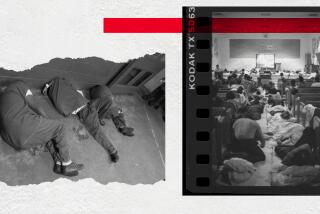One escape bid was cut short when the would-be fugitive found he had left his wheelchair brakes on.
- Share via
STATE PARK, S.C. — There are no walls, few bars on the windows, and the guards don’t wear guns except at night.
The inmates, both men and women, are referred to as “residents” and are addressed as “Mister” or “Miss.” They wear civilian clothes, live in homey, well-kept dormitories and have access to medical care around the clock. At 65, they may “retire,” but most continue working--tending gardens, weaving baskets and making handicrafts.
“We try to treat people with dignity and respect,” says Warden Judy Anderson, 45, a bubbly, former high school English teacher. “My philosophy is no matter whether you are a number, you are a person.”
Welcome to State Park Correctional Center, South Carolina’s answer to a growing national problem: the aging of America’s convict population.
Over the last decade, the number of inmates over age 55 in state and federal prisons has more than doubled, to 18,801. That is only about 3% of a prison population of 604,824, but penologists say that trends toward longer sentences and away from early parole are certain to result in a much larger geriatric population in the years ahead.
Few Over-55 Facilities
Only about a dozen states, not including California, now have special facilities for elderly prisoners. “Most states house these inmates in the general population and provide no programming especially designed to meet their needs,” a 1985 report from the National Institute of Corrections said.
Part of the reason is cost. Although elderly inmates present few disciplinary concerns and little escape risk, they do--as senior citizens everywhere--pose a variety of other problems, including long-term medical care, proper diet, facilities that can accommodate wheelchairs and protection from aggressive younger inmates.
State Park, opened in 1984 on the wooded grounds of a former state tuberculosis hospital, is widely regarded as a model for this type of facility.
About 60 of the state’s 301 elderly inmates are confined here. Admission is restricted to prisoners who are 55 or older, have certain medical conditions and are trustworthy enough to reside in a minimum-security environment. About 30 younger, able-bodied male inmates help maintain the buildings and grounds, and about 150 women prisoners involved in a work-release program also stay at the prison.
Sick call takes place twice daily and, on an average day, a fifth of the elderly inmates may seek help for a variety of ailments. Each month, more than 900 prescriptions are filled at the prison.
Special hours are reserved at mealtime in the cafeteria for elderly inmates on special diets. About 40 residents work in the prison greenhouse under supervision of a staff horticulturist.
Endorsement of a ‘Lifer’
“If you have to be in prison, this is the place to be,” said one inmate. “This is the best institution they’ve got for a person that’s sick,” added James Bearden, 69, a “lifer” who suffers from emphysema. He was sentenced in 1938 for murder.
Letha Cantey, 72, is serving seven years for cocaine-selling. At the women’s prison where she did time previously, the younger inmates “don’t care nothing about what they do or say,” she said. “Here, if a lady bumps into you, she’ll say ‘Excuse me.’ ”
State Park’s coed aspect is another welcome feature. Sara Mozingo, 60, who is in the ninth year of a 24-year sentence for a crime she would not discuss, has found steady companionship in a male resident whom, ironically, she first met decades ago in the South Carolina community where they both grew up.
“We sit together at meals, go to AA meetings and attend church together in the chapel,” she said. “It helps pass the time away. Passing the time away is the hardest thing” about being in any prison, she said.
But it’s still a prison.
Typical Prison Problems
Overcrowding and understaffing are problems at State Park as elsewhere in South Carolina’s prison system. State Park inmates also have the standard complaints about food, treatment at the hands of the guards, loneliness and restrictions on their personal activities.
Because of the openness of the institution and the mixing together of sexes and ages, State Park is more restrictive in many small matters than the ordinary prison. For example, men and women may touch hands only; all other physical contact is forbidden. Officers are always on the alert for infractions, which can result in extra work duty or loss of “good time” credit toward early release.
About one escape attempt is made each year by an elderly resident. None has succeeded. One attempt a few years ago was cut short when the would-be fugitive discovered he had left the brakes on his wheelchair on.
More to Read
Sign up for Essential California
The most important California stories and recommendations in your inbox every morning.
You may occasionally receive promotional content from the Los Angeles Times.










